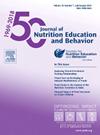在大学中导航食品不安全:在学年期间住房和食物资源使用的作用
IF 2.3
3区 医学
Q2 EDUCATION, SCIENTIFIC DISCIPLINES
引用次数: 0
摘要
由于整个学年(包括假期)生活环境的变化,大学生会独特地经历食品不安全。目的比较一学年中5个时间点的粮食安全状况、住房和食物资源使用的变化。研究设计、环境、参与者本研究采用重复横断面设计。五项在线调查在2023年11月至2024年4月之间进行,分别在两次学术假期之前、期间和之后进行。符合条件的参与者是至少18岁的中西部私立大学的全日制本科生。可测量的结果/分析参与者(n=79)在5个时间点用2项筛选器完成了美国农业部食品安全调查简短表格(6项)来测量FSS。根据原始分数,每个参与者在每个时间点被分配一个FSS(高或边缘,低或非常低)。参与者报告了他们在每个时间点的住房情况(即校外住房)和使用的食物资源(即食品储藏室)。使用Wilcoxon秩号检验分析时间点间FSS的差异。采用单因素方差分析比较各时间点住房的FSS。McNemar试验用于评估获取食物资源的变化。结果5个时间点间FSS差异无统计学意义。然而,那些在寒假期间住在校外住房的学生的FSS明显低于与家人住在一起的学生[F(2,53)=3.49, p=0.038]。不同时间点的食物资源使用有显著差异。例如,与学期相比,更多的参与者表示在寒假期间得到了家庭的食物支持,而更少的参与者表示在寒假期间与室友分享食物和分享饭菜。结论sfss在整个学年中不会改变。然而,学生使用的食物资源每学期都会改变,包括休息时间。在休息时间和家人呆在一起的学生可能不太可能经历食品不安全。资助:布拉德利大学资助项目办公室本文章由计算机程序翻译,如有差异,请以英文原文为准。
Navigating Food Insecurity in College: The Role of Housing and Food Resource Use During an Academic Year
Background
College students uniquely experience food insecurity due to changes in living situation throughout the academic year, including breaks.
Objective
Compare changes in food security status (FSS), housing, and food resources used across 5 time points during an academic year.
Study Design, Settings, Participants
This study used a repeated cross-sectional design. Five online surveys were distributed between November 2023 and April 2024, capturing before, during, and after two academic breaks. Eligible participants were at least 18 years old and full-time undergraduate students at a Midwestern private university
Measurable Outcome/Analysis
Participants (n=79) completed the USDA Food Security Survey Short-Form (6-item) with a 2-item screener at 5 time points to measure FSS. Based on a raw score, each participant was assigned a FSS (high or marginal, low, or very low) during each time point. Participants reported their housing situation (i.e. off-campus housing) and food resources used (i.e. food pantry) during each time point. Differences in FSS between time points were analyzed using the Wilcoxon Ranked Signs Test. One-way ANOVA was utilized to compare FSS by housing at each time point. McNemar test was used to evaluate changes in food resources accessed.
Results
There were no significant differences in FSS between the 5 time points. However, those who lived in off-campus housing during winter break had significantly lower FSS compared to those who lived with family [F(2,53)=3.49, p=0.038]. There were significant differences in food resources used between time points. For example, significantly more participants reported receiving family support for food and significantly less participants reported splitting food with roommates and sharing meal swipes during winter break compared to the semester.
Conclusions
FSS may not change throughout the academic year for all students. However, the food resources students use can change each semester, including breaks. Students who stay with family during breaks may be less likely to experience food insecurity.
Funding
Bradley University Office of Sponsored Programs
求助全文
通过发布文献求助,成功后即可免费获取论文全文。
去求助
来源期刊
CiteScore
4.20
自引率
11.50%
发文量
379
审稿时长
44 days
期刊介绍:
The Journal of Nutrition Education and Behavior (JNEB), the official journal of the Society for Nutrition Education and Behavior, is a refereed, scientific periodical that serves as a global resource for all professionals with an interest in nutrition education; nutrition and physical activity behavior theories and intervention outcomes; complementary and alternative medicine related to nutrition behaviors; food environment; food, nutrition, and physical activity communication strategies including technology; nutrition-related economics; food safety education; and scholarship of learning related to these areas.
The purpose of JNEB is to document and disseminate original research and emerging issues and practices relevant to these areas worldwide. The Journal of Nutrition Education and Behavior welcomes evidence-based manuscripts that provide new insights and useful findings related to nutrition education research, practice and policy. The content areas of JNEB reflect the diverse interests in nutrition and physical activity related to public health, nutritional sciences, education, behavioral economics, family and consumer sciences, and eHealth, including the interests of community-based nutrition-practitioners. As the Society''s official journal, JNEB also includes policy statements, issue perspectives, position papers, and member communications.

 求助内容:
求助内容: 应助结果提醒方式:
应助结果提醒方式:


